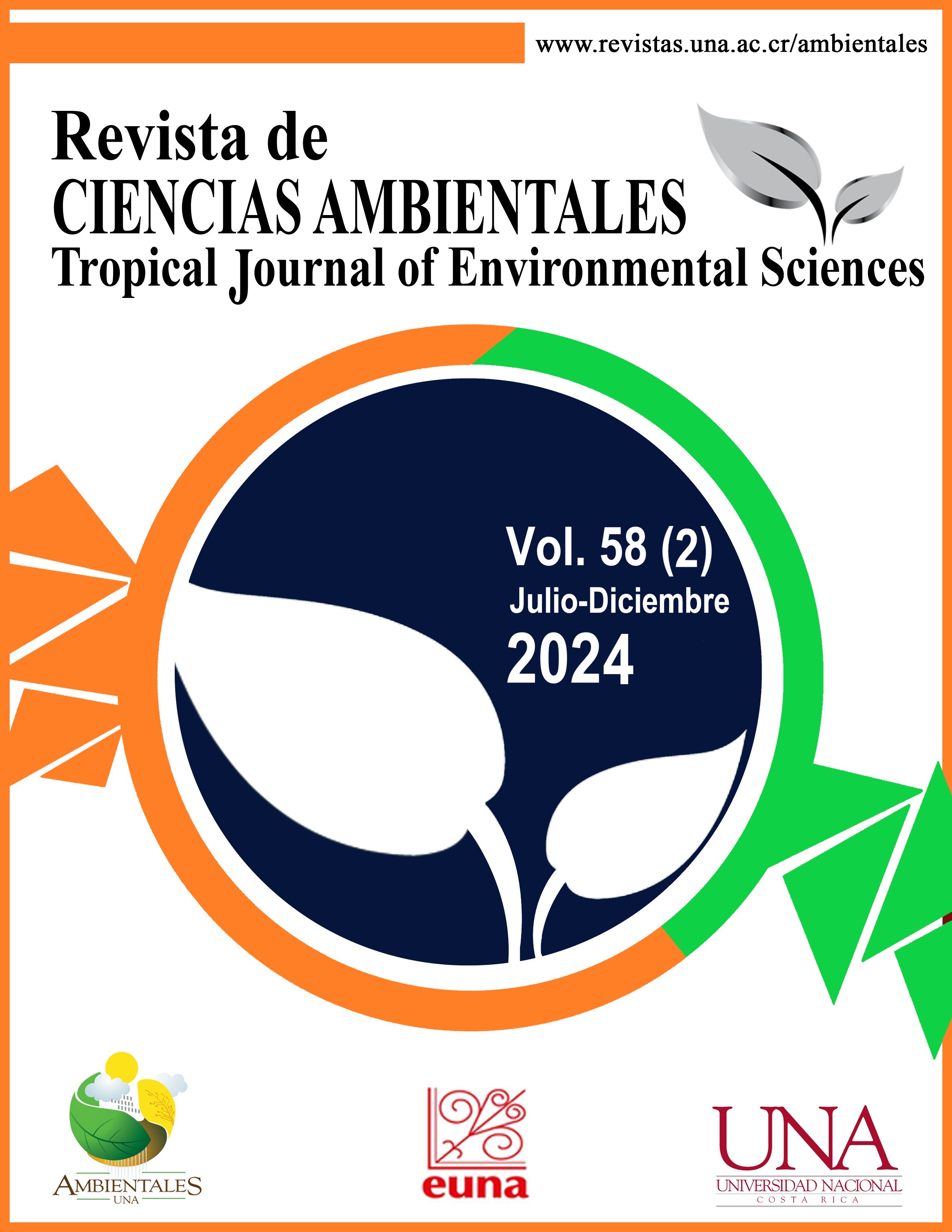Acoustic characterization of private lands under payment for environmental services at Golfo Dulce Forest Reserve, Costa Rica
DOI:
https://doi.org/10.15359/rca.58-2.1Keywords:
acoustic indices;, acoustic monitoring;, automatic detection;, conservation;, soundscapeAbstract
[Introduction]: In Latin America, the sensitive tropical biodiversity found outside of protected wilderness areas is under threat. In Costa Rica, the payment for environmental services (PSA) represents a mechanism to protect forests on private farms, but it lacks specific indicators on the state of biodiversity and forest conservation. [Objective]: To analyze the use of acoustic monitoring for ecosystem assessment at 11 sites in the Osa Peninsula, nine on private farms, and two sites within Corcovado National Park. [Methods]: Soundscapes were recorded from May 25 to June 1, 2021, using acoustic recorders. It was analyzed the behavior of six acoustic indices at each sampling site and applied an automated detection analysis of vocalizations of two representative bird species of the area. [Results]: It was found that the most fragmented sites presented higher activity, energy, and acoustic diversity, possibly due to edge effects and ecotones present, as well as a high forest component in the surrounding matrix. Automated vocalization detection indicated that the species Hylopezus perspicillatus turned out to be more sensitive to differences in the landscape than Trogon bairdii. [Conclusions]: The use of acoustic indices, although it associates features of the degree of conservation, was not a differentiating element of the quality of the ecosystem in the evaluated farms. The monitoring of
species through the detection of their vocalizations was promising. A careful and rigorous sampling design, with more
sampling points per site, is recommended to achieve accurate measurements and avoid bias in the analysis.
References
Alcocer, I., Lima, H., Sugai, L. S. M. y Llusia, D. (2022). Acoustic indices as proxies for biodiversity: a meta‐analysis. Biological Reviews, 97(6), 2209-2236. https://doi.org/10.1111/brv.12890
Bermúdez-Rojas, T. y Obando-Acuña, V. (2021). Biodiversidad en cifras: avances en el conocimiento de especies en Costa Rica. Biocenosis, 32(2), 51-58. https://doi.org/10.22458/rb.v32i2.3899
Bhakti, T., Goulart, F., de Azevedo, C. S. y Antonini, Y. (2018). Does scale matter? The influence of three-level spatial scales on forest bird occurrence in a tropical landscape. PLoS One, 13(6), e0198732. https://doi.org/10.1371/journal.pone.0198732
Boelman, N. T., Asner, G. P., Hart, P. J. y Martin, R. E. (2007). Multi‐trophic invasion resistance in Hawaii: bioacoustics, field surveys, and airborne remote sensing. Ecological Applications, 17(8), 2137-2144. https://doi.org/10.1890/07-0004.1
Bradfer-Lawrence, T., Bunnefeld, N., Gardner, N., Willis, S. G. y Dent, D. H. (2020). Rapid assessment of avian species richness and abundance using acoustic indices. Ecological Indicators, 115, 106400. https://doi.org/10.1016/j.ecolind.2020.106400
Bradfer‐Lawrence, T., Gardner, N., Bunnefeld, L., Bunnefeld, N., Willis, S. G. y Dent, D. H. (2019). Guidelines for the use of acoustic indices in environmental research. Methods in Ecology and Evolution, 10(10), 1796-1807. https://doi.org/10.1111/2041-210X.13254
Breiman, L. (2001). Random forests. Machine learning, 45(1), 5-32. https://doi.org/10.1023/A:1010933404324
Brooks, M. E., Kristensen, K., van Benthem, K. J., Magnusson, A., Berg, C. W., Nielsen, A., Skaug, H. J., Mächler, M. y Bolker, B. M. (2017). glmmTMB Balances Speed and Flexibility Among Packages for Zero-inflated Generalized Linear Mixed Modeling. https://doi.org/10.32614/RJ-2017-066
Carantón-Ayala, D. y Certuche-Cubillos, K. (2010). A new species of antpitta (Grallariidae: Grallaria) from the northern sector of the western Andes of Colombia. Ornitología Colombiana, 9, 56-70.
Carrara, E., Arroyo-Rodríguez, V., Vega-Rivera, J. H., Schondube, J. E., de Freitas, S. M. y Fahrig, L. (2015). Impact of landscape composition and configuration on forest specialist and generalist bird species in the fragmented Lacandona rainforest, Mexico. Biological Conservation, 184, 117-126. https://doi.org/10.1016/j.biocon.2015.01.014
Das, N., Mondal, A., Chaki, J., Padhy, N. y Dey, N. (2020). Machine Learning Models for Bird Species Recognition Based on Vocalization: A Succinct Review. Information Technology and Intelligent Transportation Systems, 117-124.
Depraetere, M., Pavoine, S., Jiguet, F., Gasc, A., Duvail, S. y Sueur, J. (2012). Monitoring animal diversity using acoustic indices: implementation in a temperate woodland. Ecological Indicators, 13(1), 46-54. https://doi.org/10.1016/j.ecolind.2011.05.006
Dröge, S., Martin, D. A., Andriafanomezantsoa, R., Burivalova, Z., Fulgence, T. R., Osen, K., ... y Kreft, H. (2021). Listening to a changing landscape: Acoustic indices reflect bird species richness and plot-scale vegetation structure across different land-use types in north-eastern Madagascar. Ecological Indicators, 120, 106929. https://doi.org/10.1016/j.ecolind.2020.106929
Elbers, J. (2011). Áreas protegidas de América Latina: situación actual y perspectivas para el futuro. Madrid, España: UICN-Unión Internacional para la Conservación de la Naturaleza y de los Recursos Naturales, 227p.
ESRI. (2016). ArcGIS Desktop: Release 10.5. Redlands, California, USA: Environmental Systems Research Institute
Ezzine de Blas, D., Rico, L., Ruiz Pérez, M. y Maris, V. (2011). La biodiversidad en el universo de los pagos por servicios ambientales: desentrañando lo inextricable. Revista Española de Estudios Agrosociales y Pesqueros, 228, 11-47.
Fahrig, L., Arroyo-Rodríguez, V., Bennett, J. R., Boucher-Lalonde, V., Cazetta, E., Currie, D. J. y Watling, J. I. (2019). Is habitat fragmentation bad for biodiversity? Biological Conservation, 230, 179-186. https://doi.org/10.1016/j.biocon.2018.12.026
Fahrig, L. (2003). Effects of habitat fragmentation on biodiversity. Annual review of ecology, evolution, and systematics, 34(1), 487-515.
Fairbrass, A. J., Rennert, P., Williams, C., Titheridge, H., & Jones, K. E. (2017). Biases of acoustic indices measuring biodiversity in urban areas. Ecological Indicators, 83, 169-177.
Garrigues, R. y Dean, R. (2014). The birds of Costa Rica, a field guide. Ithaca Nueva York, Cornell University Press.
Gonçalves, S., Pieretti, N., Young, R. J., & Duarte, M. (2021). Biophony in a noisy tropical urban forest fragment. Biota colombiana, 22(1), 96-107. https://doi.org/10.21068/c2021.v22n01a06
González-Maya, J. F., Víquez-R, L. R., Belant, J. L. y Ceballos, G. (2015). Effectiveness of Protected Areas for Representing Species and Populations of Terrestrial Mammals in Costa Rica. PLoS ONE, 10(5), e0124480. https://doi.org/10.1371/journal.pone.0124480
Hartig, F. (2022). DHARMa: Residual Diagnostics for Hierarchical (Multi-Level / Mixed) Regression Models. R package version 0.4.5. https://CRAN.R-project.org/package=DHARMa
Hartigan, J. A., & Wong, M. A. (1979). Algorithm AS 136: A k-means clustering algorithm. Journal of the Royal Statistical Society. Series c (Applied statistics), 28(1), 100-108.
K. Lisa Yang Center for Conservation Bioacoustics at the Cornell Lab of Ornithology. (2022). Raven Pro: Interactive Sound Analysis Software (Version 1.6.3) [Computer software]. Ithaca, N. Y.: The Cornell Lab of Ornithology. https://ravensoundsoftware.com/
Kark, S. (2013). Effects of ecotones on biodiversity. Encyclopedia of biodiversity, 142-148. https://doi.org/10.1016/B978-0-12-384719-5.00234-3
Kasten, E. P., Gage, S. H. y Fox, J. (2012). The remote environmental assessment laboratory’s acoustic library: an archive for studying soundscape ecology. Ecological Informatics, 12, 50-67. https://doi.org/10.1016/j.ecoinf.2012.08.001
Keene, K. A. y Barlow, B. (2019). Benefits & Drawbacks to Variable-Radius Plots. Extension Alabama A&M & Auburn Universities. https://www.aces.edu/blog/topics/forestry/benefits-drawbacks-to-variable-radius-plots/
Kuhn, M. (2008). Building Predictive Models in R Using the caret Package. Journal of Statistical Software, 28(5), 1-26. https://doi.org/10.18637/jss.v028.i05
Metcalf, O. C., Barlow, J., Devenish, C., Marsden, S., Berenguer, E. y Lees, A. C. (2021). Acoustic indices perform better when applied at ecologically meaningful time and frequency scales. Methods in Ecology and Evolution, 12(3), 421-431. https://doi.org/10.1111/2041-210X.13521
Minello, M., Calado, L. y Xavier, F. C. (2021). Ecoacoustic indices in marine ecosystems: a review on recent developments, challenges, and future directions. ICES Journal of Marine Science, 78(9), 3066-3074. https://doi.org/10.1093/icesjms/fsab193
Mitchell, S. L., Bicknell, J. E., Edwards, D. P., Deere, N. J., Bernard, H., Davies, Z. G., & Struebig, M. J. (2020). Spatial replication and habitat context matters for assessments of tropical biodiversity using acoustic indices. Ecological Indicators, 119, 106717.
Nieto-Mora, D. A., Rodríguez-Buritica, S., Rodríguez-Marín, P., Martínez-Vargaz, J. D. y Isaza-Narváez, C. (2023). Systematic review of machine learning methods applied to ecoacoustics and soundscape monitoring. Heliyon, 9(10). https://doi.org/10.1016/j.heliyon.2023.e20275
Pérez‐Granados, C. y Traba, J. (2021). Estimating bird density using passive acoustic monitoring: a review of methods and suggestions for further research. Ibis, 163(3), 765-783. https://doi.org/10.1111/ibi.12944
Pieretti, N., Farina, A. y Morri, D. (2011). A new methodology to infer the singing activity of an avian community: the acoustic complexity index (ACI). Ecological Indicators, 11, 868-873. https://doi.org/10.1016/j.ecolind.2010.11.005
Porras, I. y Chacón-Cascante, A. (2018). Costa Rica’s Payments for Ecosystem Services Programme. International Institute for Environment and Development. https://www.iied.org/g04272
Pringle, R. M. (2017). Upgrading protected areas to conserve wild biodiversity. Nature, 546(7656), 91-99. https://doi.org/10.1038/nature22902
Rempel, R. S., Kaukinen, D. y Carr, A. P. (2012). Patch analyst and patch grid. Ontario Ministry of Natural Resources. Centre for Northern Forest Ecosystem Research, Thunder Bay, Ontario.
Renjifo, L. M. y Amaya-Villarreal, Á. M. (2017). Evolución del riesgo de extinción y estado actual de conservación de las aves de Colombia. Revista de la Academia Colombiana de Ciencias Exactas, Físicas y Naturales, 41(161), 490-510. https://doi.org/10.18257/raccefyn.461
Rosli, Z., Zakaria, M. y Rajpar, M. N. (2018). Edge effects on foraging guilds of upperstory birds in an isolated tropical rainforest of Malaysia. JAPS: Journal of Animal & Plant Sciences, 28(1).
Sánchez-Chaves, O., & Navarrete-Chacón, G. (2017). La experiencia de Costa Rica en el pago por servicios ambientales: 20 años de lecciones aprendidas. Revista de Ciencias Ambientales, 51(2), 195-214. https://doi.org/10.15359/rca.51-2.11
Schulze, C. H. y Riedl, I. (2008). Bird assemblages of forested and human-modified countryside habitats in the Pacific lowlands of southern Costa Rica. Stapfia, 88(80), 395-408.
Slabbekoorn, H. (2004). Habitat-dependent ambient noise: consistent spectral profiles in two African forest types. The Journal of the Acoustical Society of America, 116(6), 3727-3733. https://doi.org/10.1121/1.1811121
Sueur, J., Aubin, T. y Simonis, C. (2008). Seewave, a free modular tool for sound analysis and synthesis. Bioacoustics, 18(2), 213-226. https://doi.org/10.1080/09524622.2008.9753600
Towsey, M., Wimmer, J., Williamson, I. y Roe, P. (2014). The use of acoustic indices to determine avian species richness in audio-recordings of the environment. Ecological Informatics, 21, 110-119. https://doi.org/10.1016/j.ecoinf.2013.11.007
Towsey, M. W. (2013). Noise removal from wave-forms and spectrograms derived from natural recordings of the environment. http://eprints.qut.edu.au/41131/
Valente, J. J. y Betts, M. G. (2019). Response to fragmentation by avian communities is mediated by species traits. Diversity and Distributions, 25(1), 48-60. https://doi.org/10.1111/ddi.12837
Vega-Hidalgo, A., Flatt, E., Whitworth, A. y Symes, L. (2021). Acoustic assessment of experimental reforestation in a Costa Rican rainforest. Ecological Indicators, 133, 108413. https://doi.org/10.1016/j.ecolind.2021.108413
Villanueva-Rivera, L. J. y Pijanowski, B. C. (2018). Soundecology: soundscape ecology. R package version. 1(3), 3. https://cran.r-project.org/web/packages/soundecology/soundecology.pdf
Villanueva-Rivera, L. J., Pijanowski, B. C., Doucette, J. y Pekin, B. (2011). A primer of acoustic analysis for landscape ecologists. Lanndscape Ecology, 26(9), 1233-1246. https://doi.org/10.1007/s10980-011-9636-9
Wildlife Acoustics Inc. (2023). Kaleidoscope User Guide. Maynard, Massachusetts. https://www.wildlifeacoustics.com/uploads/user-guides/Kaleidoscope-User-Guide.pdf
Yip, D. A., Bayne, E. M., Sólymos, P., Campbell, J. y Proppe, D. (2017). Sound attenuation in forest and roadside environments: Implications for avian point-count surveys. The Condor: Ornithological Applications, 119(1), 73-84. https://doi.org/10.1650/CONDOR-16-93.1
Published
How to Cite
Issue
Section
License
Copyright (c) 2024 Tropical Journal of Environmental Sciences

This work is licensed under a Creative Commons Attribution-NonCommercial-ShareAlike 4.0 International License.

This work is licensed under a Creative Commons Attribution-NonCommercial-ShareAlike 4.0 International License.



















